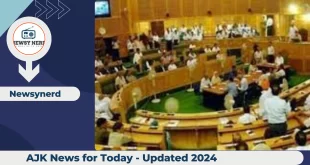Policy officials, investors, and analysts have all shown a great deal of interest in Pakistan’s economy. Pakistan’s economy is expected to increase by 1.7% in fiscal year 2024 (FY24), according to latest World Bank projections. It is anticipated that growth will be hampered by political unrest and weak private demand. In view of the challenges of inflation, this article on Pakistan Economy News examines the future prospects and evaluates the variables driving Pakistan’s economic growth.
Current Economic Scenario
One cannot overestimate the detrimental effects of political unrest on private demand and Pakistan’s overall economic growth. Businesses and investors feel unpredictable because of the lack of clarity regarding government plans and the constant turnover of leadership. Decisions about investments are frequently postponed, and recruiting and expansion strategies are cautious as a result of uncertainty in this Pakistan Economy News.
Furthermore, the execution of important economic reforms is hampered by political instability. Reforms intended to boost infrastructure development, draw in foreign direct investment, and improve the business climate all need steady policy backing and efficient implementation. The political unrest, however, takes resources and attention away from these reform initiatives, slowing down the rate of advancement.
Pakistan has demonstrated tenacity and resolve in seeking economic stabilization and change in spite of these obstacles. Positive outcomes from structural reforms, such as enhanced tax administration and ease of doing business, are beginning to appear. Remittance inflows have also increased significantly in the nation, and these inflows have been vital in bolstering the economy and stabilizing the external sector. Important industries like manufacturing and agriculture have also recovered, which adds to the optimistic economic picture. Particularly the agriculture industry has profited from good weather patterns, a greater emphasis on mechanization, and government programs aimed at enhancing agricultural output. Along with the manufacturing sector, export-oriented policies and rising domestic demand have contributed to the sector’s resurgence.
Thus, Pakistan has made great progress in stabilizing the economy and putting the required reforms in place, despite the hurdles posed by the continuous political unrest to the nation’s economic growth. Given the mix of significant remittance inflows, structural changes, and the recovery in important industries, the 1.7% growth estimate for FY24 represents cautious optimism. That being said, maintaining and accelerating economic growth in the future will require the restoration of political stability and steady governmental support.
Challenges and Impediments to Growth – Pakistan Economy News
Anxiety in politics, especially when it manifests as recurring shifts in the administration and unclear policies, is bad for investor confidence and business ventures. A slowdown in private demand results from businesses delaying investment decisions when they are unsure about the stability of the economic climate. Productivity gains, the generation of jobs, and general economic expansion may be hampered by this.
A sizable informal sector, a low tax-to-GDP ratio, and insufficient social safety nets are further major obstacles Pakistan faces. These constraints exacerbate socioeconomic inequality and impede inclusive growth by limiting the government’s capacity to raise revenue and deliver necessary public services.
Inflationary Pressure and its Impact – Pakistan Economy News

In the upcoming years, inflation is a critical issue that will influence Pakistan’s economic growth. Pakistan has had significant rates of inflation recently, mostly due to rising food and energy costs. Consumers’ purchasing power is diminished by inflation, which also lowers disposable income and has a detrimental impact on the profitability of businesses. It can therefore inhibit investment and private spending, which would impede economic progress.
On the other hand, growth-friendly conditions might be created if inflationary pressures lessen. Achieving this goal will depend heavily on the government’s attempts to reduce inflation through supply-side initiatives, cautious monetary policy, and structural changes. If effective, reduced inflation rates can boost investment, boost private demand, and open the door to faster economic expansion. This Pakistan Economy News can assist policy makers in designing a well-planned policy.
Future Outlook and Policy Recommendations
Pakistan’s economy is predicted to increase by 2.4% in FY25, provided that political unrest is resolved and the regulatory landscape becomes more stable. Policymakers must concentrate on a few crucial areas in order to attain this growth trajectory:
1. Political Stability
To regain investor trust and draw in both local and foreign investment, it is essential to maintain political stability and policy continuity. Robust governance changes, open decision-making procedures, and efficient economic policy execution can accomplish this.
2. Budgetary Reforms
Encouraging revenue creation and budgetary management are essential for robust economic growth. Pakistan needs to expand its revenue base, improve tax administration, and rely less on foreign borrowing in order to free up funds for investments in infrastructure, healthcare, and education.
3. Investment in Human Capital
It is imperative to spend money on healthcare, education, and skill development in order to boost productivity and competitiveness. By giving improving its human resources first priority, Pakistan’s workforce can be ready to support economic success and adjust to changes in technology.
4. Infrastructure Development
Investments and economic activity are made easier when infrastructure is improved, especially in the areas of energy, transportation, and digital connectivity. Infrastructure spending can improve output, lower transaction costs, and the business climate generally.
Predictions from the World Bank indicate that Pakistan’s GDP will grow at a 1.7% annual pace in FY24. Sustained economic growth is, however, severely hampered by political unrest and weak private demand. Building infrastructure, investing in human capacity, implementing budgetary reforms, and maintaining political stability are all necessary to meet these difficulties. We can manage a lot of economic issues if these factors are considered in detail.
Pakistan’s economic future will also be greatly influenced by how well inflationary pressures are managed. Pakistan may overcome these challenges and realize its full growth potential with the correct governmental actions and a supportive economic environment. It requires well-planned and informed policy-making by the involvement of all the stakeholders to take some essential measures. It is not a hard task but requires consideration and willingness to be executed properly for the betterment of the country’s overall economy.
 Newsy Nerd
Newsy Nerd

